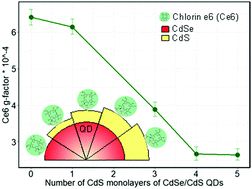Influence of CdSe and CdSe/CdS nanocrystals on the optical activity of chiral organic molecules†
Abstract
The field of chiral nanoparticles has received a great deal of attention due to a wide range of potential applications offered by these materials in chiral sensing, in catalysis and in advanced optical devices. A large number of studies have focused on the optical activity of semiconductor nanocrystals induced by chiral ligands adsorbed on the nanocrystal's surface. Here for the first time, we report an experimental study on the opposite effect and the influence of semiconductor nanocrystals on the optical activity of chiral molecules. Hybrid nanostructures based on a chiral organic dye, chlorin e6, and various semiconductor nanocrystals (CdSe quantum dots of a range of diameters, core/shell CdSe/CdS quantum dots and CdSe/CdS dot-in-rods) were synthesized and characterized using spectroscopic techniques. Overall, it has been found that the chlorin e6 optical activity increases when chlorin e6 was bound to nanocrystals. In the case of CdSe QDs, this phenomenon showed a strong dependency on the quantum dot size, with smaller diameters resulting in a larger optical activity increase and vice versa. Moreover, in the case of core/shell CdSe/CdS QDs, it was found that by varying the nanocrystal shell thickness, it was possible to control the resulting distance between the nanocrystal core and chlorin e6. From this, it has been established that decreasing the distance between the nanocrystal core and chlorin e6 resulted in an increase in the chlorin e6 optical activity.



 Please wait while we load your content...
Please wait while we load your content...